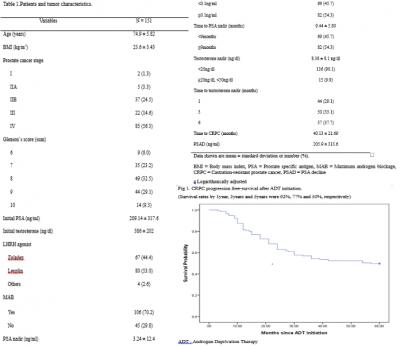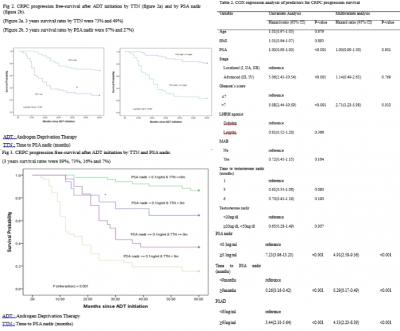|
Cancer - Prostate(구연)
|
(E-136)
|
|
|
일차 안드로겐 박탈 요법 후 거세 저항성 전립선 암의 진행에 대한 예측 인자 ; PSA 감소와 최하점 도달 시간, PSA 최하점의 중요성 |
| 전남대학교 의과대학 비뇨의학과교실 |
| 오주용, 유성현, 김명수, 정호석, 황의창, 오경진, 김선옥, 정승일, 강택원, 권동득, 박광성 |
Purpose: Androgen deprivation therapy (ADT) has known as the standard primary systemic therapy for prostate cancer (PCa). Although PCa patients initially respond well to primary ADT, they usually progress to castration-resistant prostate cancer (CRPC). This retrospective cohort study aimed to investigate the predictor for progression of CRPC after primary ADT in hormone-naïve PCa patients.
Materials and Methods: A total of 151 patients with prostate cancer who were administered ADT for primary PCa treatment after diagnosis of PCa were enrolled. All patients were followed-up more than 5 years. Patient characteristics, PSA and testosterone at ADT initiation, PSA nadir, time to PSA nadir (TTN), testosterone nadir, time to testosterone nadir and PSA decline (PSAD) in relation to CRPC progression free-suvival were analyzed.
Results: Mean CRPC progression time after ADT initiation was 40months. Median PSA nadir, time to PSA nadir and PSAD was 0.1ng/ml, 9months and 65ng/ml, respectively. On univariate analysis; high initial PSA, advanced stage, Gleason`s score >7, PSA nadir ≥ 0.1ng/ml, TTN < 9months and PSAD ≥ 65ng/ml were related to a shorter CRPC progression-free survival. On multivariate analysis, Gleason`s score >7, PSA nadir ≥ 0.1ng/ml, TTN < 9months and PSAD ≥ 65ng/ml were independent predictor for progression of CRPC.
Conclusion: In addition to previous known factors of CRPC progression including high Gleason`s score and PSA nadir, a shorter time to PSA nadir and large PSAD were also associated with fast CRPC progression. These results may suggest that a rapid response to ADT relates with more aggressive disease. |
  |
|
keywords : Prostate cancer, Androgen deprivation therapy, CRPC |
|

